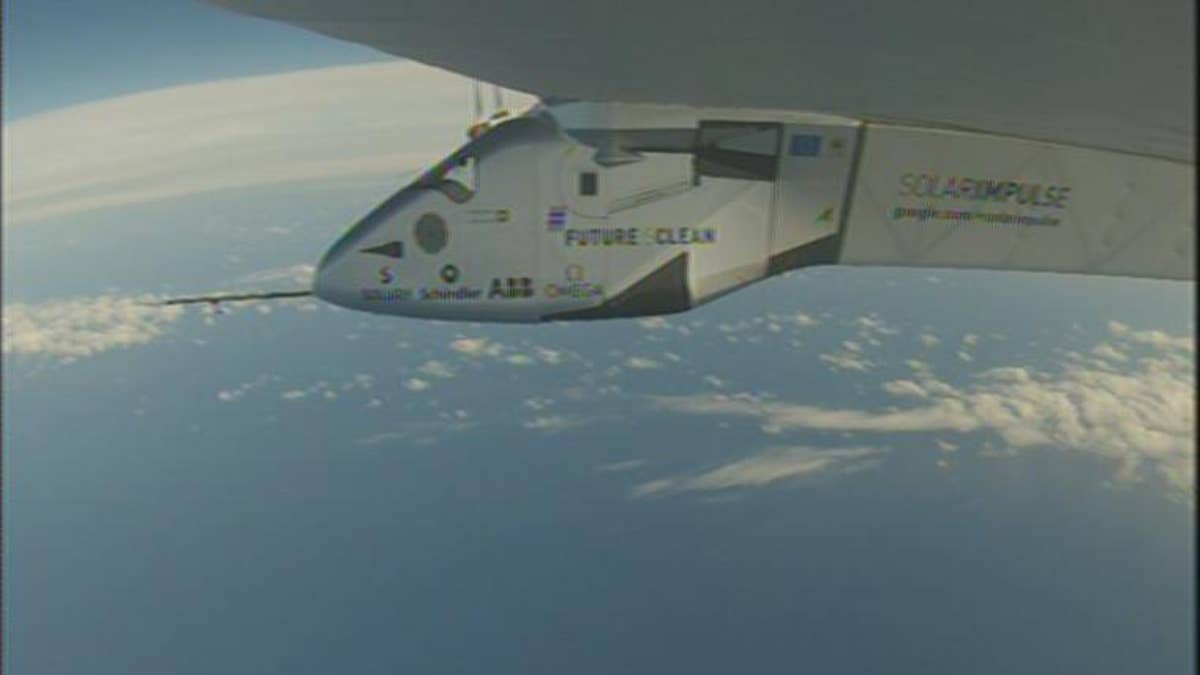
Solar Impulse 2 flies over the Pacific. (Solar Impulse)
Solar Impulse 2 is making good progress in its epic journey across the Pacific, with the plane breaking the record for longest-solar powered flight on Tuesday.
“It’s now the longest solar-powered flight ever in distance and duration,” Solar Impulse Chairman Bertrand Piccard told FoxNews.com during a phone interview from the project’s Mission Control Center in Monaco.
Related: Solar Impulse 2’s epic journey in pictures
The fuel-free one-seater plane, piloted by Andre Borschberg, was almost 2,000 miles into his 4,908-mile flight shortly after 11 a.m. ET Tuesday, easily surpassing the 1,491-mile record he set when flying from China to Japan on the previous leg of the round-the world journey.
On Tuesday, Borschberg also broke the 44-hour record for longest duration solar-powered flight that he set on the China to Japan trip.
The flight poses huge mental and physical challenges for Borschberg. Solar Impulse 2’s cockpit is too small to stand in, although the seat can recline into a horizontal position to allow him to lie down.
“He’s a little bit tired, which is normal – he’s in very good health (and) very good mood,” said Piccard. “He’s very happy with the behavior of the plane.”
Solar Impulse 2, a larger version of a single-seat prototype that first flew five years ago, is made of carbon fiber and has 17,248 solar cells built into the wing that supply the plane with renewable energy, via four motors. The solar cells recharge four lithium polymer batteries, which provide power for night flying.
Related: Solar Impulse 2 passes ‘point of no return’ in audacious attempt to cross the Pacific
The plane has a 236-foot wingspan, larger than that of the Boeing 747, but, thanks to the lightweight carbon fiber, weighs about as much as a car at around 5,070 pounds.
The aircraft climbs to the altitude of Mount Everest, almost 29,500 feet, during the day to get more sunlight, recharge the batteries and store more energy. At nighttime, the plane flies lower, at a minimum of 3,000 feet. Borschberg can experience temperatures ranging from 95 degrees Fahrenheit in the morning to minus 4 degrees Fahrenheit early in the evening while the plane is still high up.
Solar Impulse 2 typically flies between 30 mph and 40 mph during its journey, although this can increase and decrease significantly depending on wind speed.
The plane is the brainchild of Piccard, who is taking it in turns with his fellow Swiss pilot Borschberg to fly the solar-powered aircraft on its five-month-journey across the globe.
Piccard told FoxNews.com that the seeds of the project were sown while he was completing the first-ever non-stop round-the-world balloon flight in 1999. “Almost four tons of liquid propane was burned,” he explained, adding that this inspired him Solar Impulse.

Sunset over the Pacific. (Solar Impulse)
“This was my vision, when I created that project, to fly with no fuel,” Piccard said. “Today, I am elated – this flight is demonstrating that I was not a crazy dreamer and my vision was realistic.”
Solar Impulse 2 set off from Abu Dhabi in March, and has stopped in Oman, India, Myanmar and Nanjing, China, en route to an unscheduled stop in Nagoya, Japan.
The plane originally left Nanjing, China, for Hawaii, but diverted to Japan on June 1 because of unfavorable weather ahead. It had been waiting for the right conditions to depart before Sunday’s takeoff for Hawaii.
Related: Solar Impulse 2 plane takes renewable energy and clean tech to new heights, says pilot
After 16 hours of flying, Solar Impulse 2 passed the point of no return early Monday. No immediate landing is now available to Borschberg as he attempts to reach Hawaii.
Piccard explained that, should the plane run into difficulties during its round-the-world trip, both he and Borschberg have undertaken extensive emergency training. “If a problem occurs, we’re both trained for that,” he told FoxNews.com. “We had training with the German Navy in the North Sea -- we learned how to arrive by parachute, how to inflate the liferaft and be rescued by helicopter.”
“We hope that it won’t be needed, but if it is, we can handle it,” he added.
After Hawaii, the second Pacific leg of the journey will take the plane to Phoenix. Solar Impulse 2 is slated to stop in New York before flying over the Atlantic Ocean. It will then stop in southern Europe or North Africa, depending on weather conditions.
Follow James Rogers on Twitter @jamesjrogers
